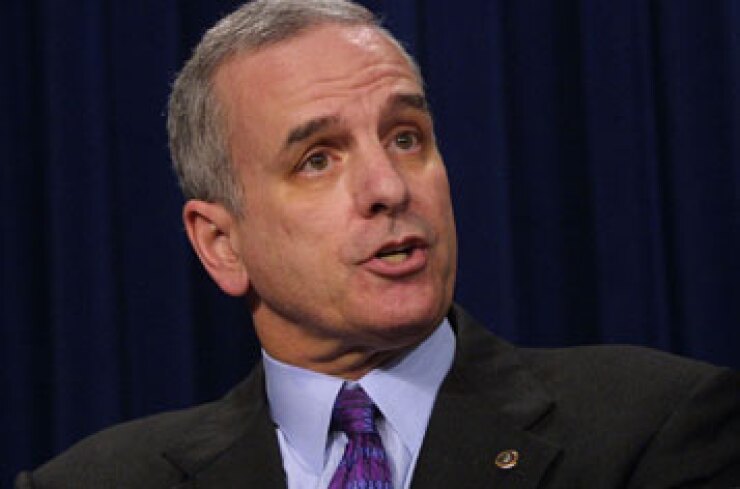
CHICAGO – Minnesota expects to close out its fiscal biennium June 30 with a $678 million balance, leaving the state $1.4 billion in surplus revenue available for the next two-year budget.
The latest projections came from Minnesota Management and Budget's annual November forecast, which comes out in early December and is followed by a February one. The figures are used to craft or adjust state budgets.
"Minnesota's budget and economic outlook remains stable, despite continued slow economic growth," the report reads. Revenues for the current biennium remain on track with an extra $41 million expected, compared with the prior forecast, while spending is down $245 million.
That will allow the state to close out the biennium with a $678 million balance after making a $334 million transfer into its budget reserves as required under law. The ending balance is down $51 million from the prior estimates. The rainy day fund deposit brings the state's reserve to $1.9 billion. Under statute, the state must transfer the first $33% of a surplus to its reserves until it reaches a $2 billion target.
For the next biennium that begins July 1, the state now expects to collect $45.3 billion in revenue with spending at $44.6 billion. The $678 million balance combined with the differential between revenues and expenses in the next two years results in a $1.4 billion surplus.
That's down by $467 million, due primarily to a lowering of estimated sales tax collection as the nation's economic outlook has weakened, the report read.
Gov. Mark Dayton, a member of the state's Democratic-Farmer-Labor Party, said the economic outlook is clouded by the election and the state should move cautiously in its use of the funds, as the projections were largely based on pre-election data. Dayton will release his budget proposal in January.
"To me, it means that we need to be cautious and prudent, and recognize that our economic growth is constrained by the national economic growth—the forecast here is for continued growth, but to a lesser level than previously forecasted," he said. "So those are going to be our constraints under, really, the best of reasonable circumstances."
Dayton sought also to highlight a shift in the state's fortunes as it erased red ink with an income tax hike on top earners and its economy grew. Six years ago, the state faced a $6.2 billion deficit and had withheld $2 billion in school aid payments. "Now, we have a projection of a $1.4 billion surplus for the next biennium, we owe nothing to the schools, $1.9 billion is parked in the budget reserve fund," he said.
The pending surplus is due in part to money left on the table during the previous legislative session, when Dayton and lawmakers couldn't resolve differences over tax relief, the size of a bonding package, and transportation funding with Republicans holding the House. Dayton will face even more opposition next year as the GOP also won a majority in the Senate in the November election.
Democratic-Farmer-Labor Party members have suggested the surplus should go to help reduce health insurance costs for state residents and greater spending on education and transportation while Republicans favor tax cuts and want to overhaul health care spending.
Minnesota won back one of its triple-A ratings ahead of its annual summer general obligation sale. Moody's Investors Service affirmed the state's Aa1 rating and stable outlook and S&P Global Ratings affirmed its AA-plus and positive rating.
The good news came from Fitch Ratings which raised the state's GOs to AAA from AA-plus. The upgrade was due to both positive credit developments and the application of Fitch's revised criteria for U.S. state and local governments released in April.
The upgrade came five years after Fitch stripped the state of its top marks for dipping too much into reserves and relying on other one-time time fiscal maneuvers to balance its books amid divided political leadership.
Fitch suggested a return to past practices could again hurt the state's credit. "The rating is sensitive to the state's ongoing strong budget management, including adherence to well-developed reserve funding policies, as well as Fitch's expectations for continued strong economic and revenue growth prospects and a low long-term liability burden," analysts wrote. The state has $6.5 billion of outstanding GOs and $1 billion of general fund appropriation bonds.





